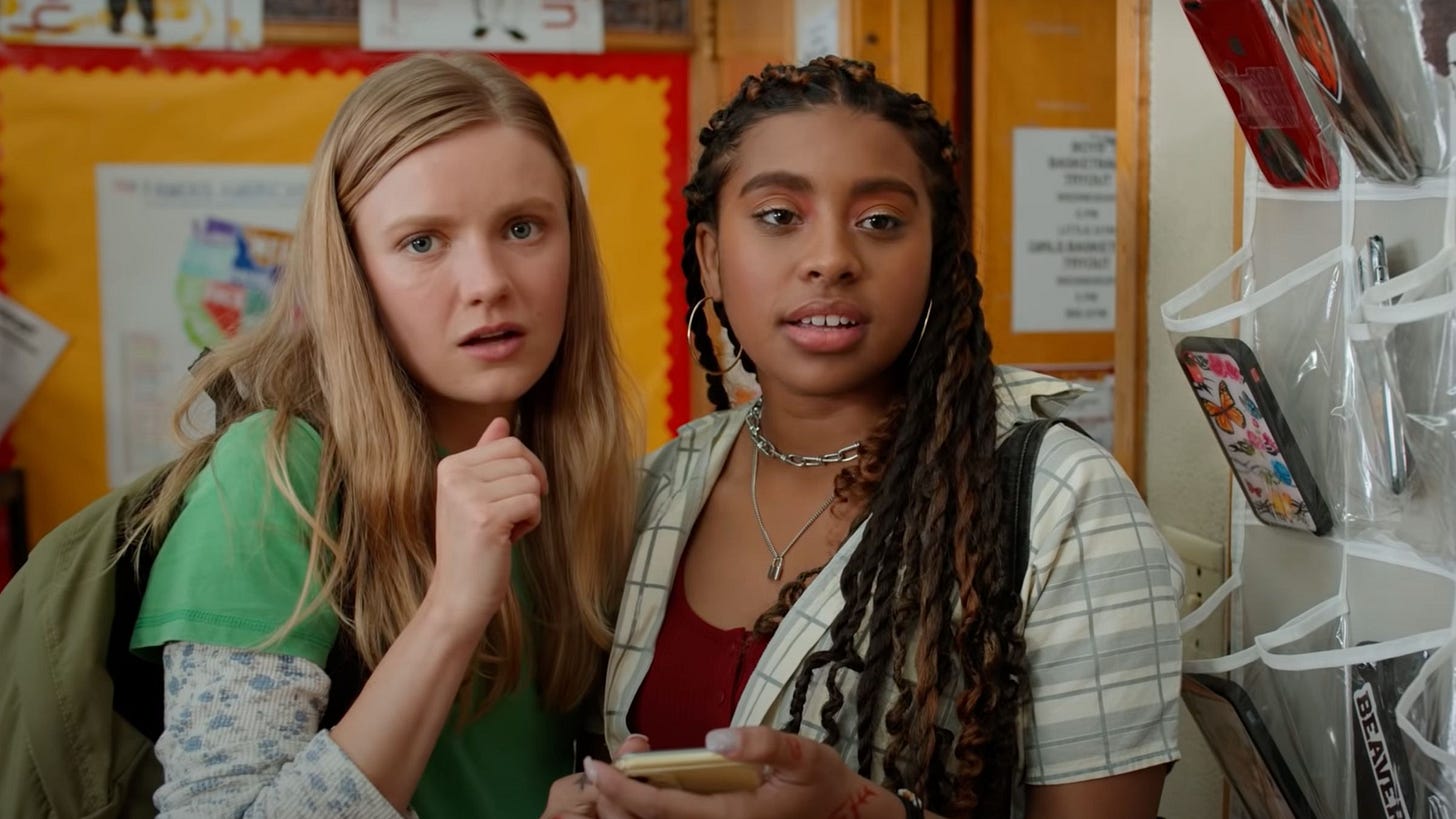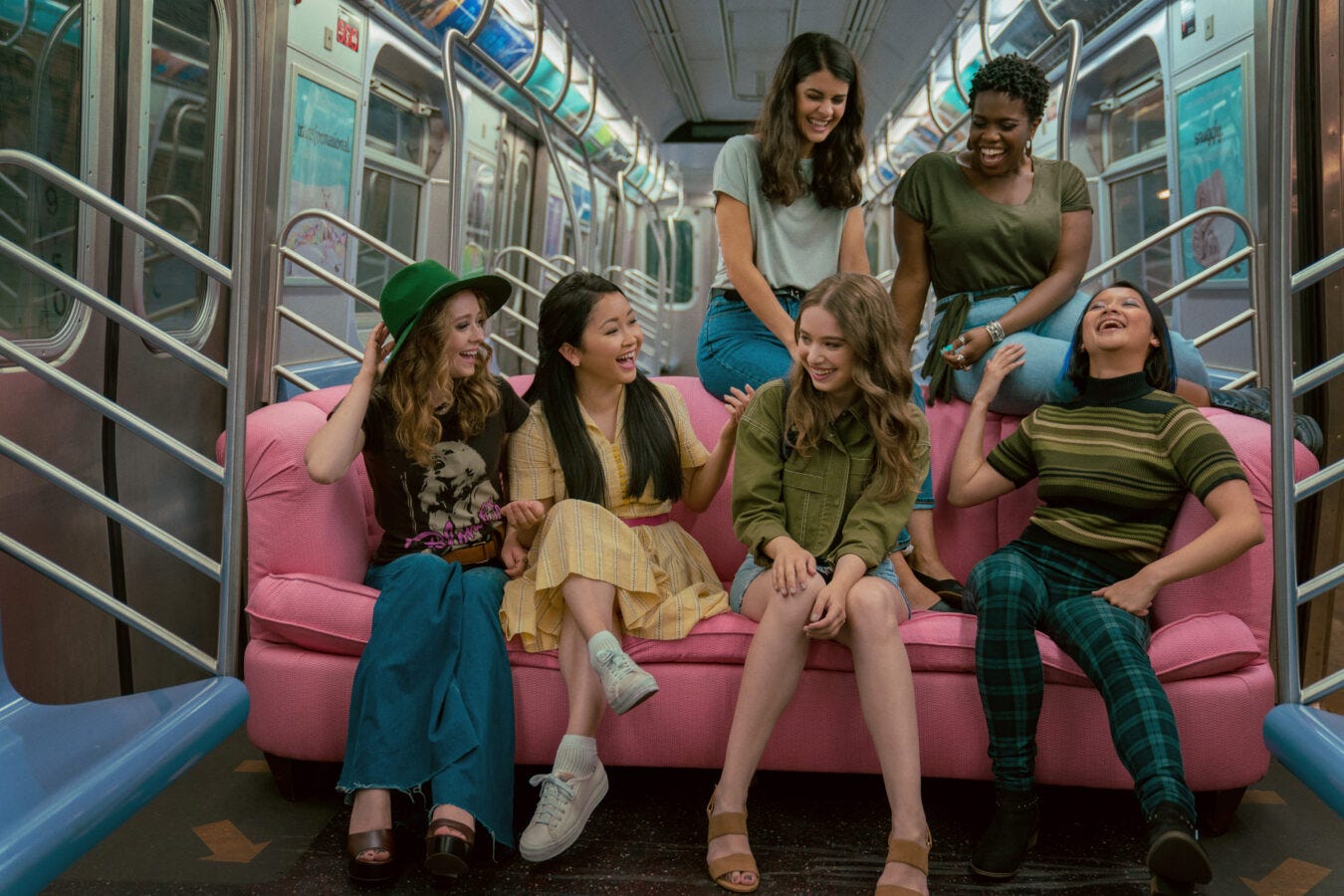This week marks one year since we’ve officially been in a pandemic. Not gonna lie, it’s rough. We’re all a year older, probably fatter (which is fine FYI!), and worn out from the monotony of being trapped in our homes. This newsletter started a pandemic project and it’ll be our anniversary soon too. But for now, we just want to cruise through March dancing on the fumes we have left and holding out for Dolly Parton’s vaccine.
In any case, it’s… been a week. Unbelievable from both a space-time perspective and also just the sheer amount of things we have to squeeze into this time frame. I won’t bore you with the details (DM for deets), but suffice it to say, March really is coming in like a lion.
So for today, we’re talking two tales of baby movers and shakers— teen girls who make shit happen. First, it’s Cate on Moxie, then Zosha on To All the Boys: Always and Forever. Read on, babes. And subscribe if you haven’t already! -Z+C
Cate on Moxie
In the last couple of weeks, we’ve all been talking about Britney Spears. The New York Times documentary Framing Britney Spears made the compelling case that the pop icon is intentionally being held hostage in a legal minefield that no longer has a vested interest in protecting her. There was a lot of excellent writing in response to the documentary, but the piece that resonated the most with me was an essay in The Cut by one-time fashion blogger and editor-in-chief of Rookie, Tavi Gevinson. She wrote:
When I entered the world of adult men as an 18-year-old, I was aware that I’d been granted access, visibility, and currency through my whiteness, thinness, cis-ness—what Janet Mock calls pretty privilege — as well as my social status. I could not reconcile my awareness of my power — and all the safety it promised — with the idea that I was also vulnerable in any way. But at the same time that beauty can confer currency, it also enforces, rather than cancels out, male dominance.
I thought about this as I watched Moxie and found myself confronting anew that uncomfortable knowledge that people socialized as girls are raised to be vulnerable. And challenging that vulnerability is always a risk—a brave one.
In Moxie, Vivian (Hadley Robinson) creates and distributes an anonymous feminist zine at her high school after new girl Lucy (Alycia Pascual-Peña) helps her see that its pervasive sexist climate isn’t something she has to simply put up with. Inspired by her mother Lisa’s (Amy Poehler) own youthful feminist rebellion, she, in turn, inspires the girls at her school to push back against the administration’s tolerance of the male students’ misogyny and the unfair expectations placed on them as girls.
Only Vivian, and eventually her new boyfriend Seth (Nico Hiraga) know that she is the zine’s originator, but the other girls take up Moxie’s mantle with gusto, spreading the word about her symbolic protest actions. They start will small acts of solidarity like drawing hearts and stars on their hands and papering the corridors with “you’re an asshole” stickers. Later, they escalate to collective action in the form of a silent dress code protest, and eventually, a walk-out.
Vivian is both fueled by her new anonymous power and beholden to it. As the group grows and becomes an official club at the school—with an assist from her long-time bestie Claudia (Lauren Tsai)—Vivian also grows more attached to enacting her own vision of the school through her zine. Moxie grows, and it emboldens her, but it also alienates her from Claudia, who as an Asian student, feels less secure in her ability to make waves.
It’s an interesting counterpoint to how the film presents Lucy and the other black female students who get significant screentime. All three are shown to be well aware of the disparities that exist between them and the school’s star athletes—specifically Mitchell (Patrick Schwarzenegger), a quarterback and serial harasser—but Vivian has to be shaken into recognition. In her first days at school, Lucy becomes a target for Mitchell’s harassment and receives no support from the administration. Vivian tells her to ignore him and keep her head down, but Lucy is the one who tells her that Mitchell is dangerous, and she doesn’t plan to shrink herself and let him keep abusing her. That simple moment serves as Vivian’s awakening, but it also opens up some questions.
Vivian is directly inspired to create Moxie by her mother’s own zines and previous activism. (“We were little assholes, we protested everything.”) But despite Lisa’s awareness of where her generation failed in their feminist movement, she doesn’t seem to have passed on any of that acquired knowledge to her daughter. A girl raised by a former riot grrrl punk shouldn’t be surprised to discover that rating girls on a list according to “bangability” is a vile and misogynist thing to do. In essence, the very thrust of this film should be impossible.
But while Moxie does take the time to address the big white elephant in the room, it doesn’t address intersectionality in a way that allows those conflicts to breathe. After Claudia is suspended as payback for one of Moxie’s protest actions, she angrily tells Vivian that she doesn’t have the luxury of kicking ass and taking names as the daughter of immigrants. Her parents sacrificed a lot to make her comfortable life possible, and she sees railing against authority as a poor way to thank them.
In what, I suppose, is a realistic response, Vivian rages, offended at the very idea that she is blind to her best friend’s struggles. But in that rage, she lashes out not just as her mother and her date, but at her own boyfriend Seth, who is also Asian. In a scene that made me cheer, Seth tells her the next day that he is not a punching bag, and doesn’t deserve to be treated like one just because Vivian is upset.
But when a student leaves a note for Moxie asking for help because her boyfriend raped her, things get serious. Rape is a bigger issue than Vivian can handle, and the student (later revealed to be Josephine Langford’s Emma) is in need of help with nowhere but Moxie to turn. The girls at the school feel empowered by the noise they’ve been making over the past weeks, but this forces them to acknowledge that there are limits to the power they have created for themselves. Teen girls can do anything, but it doesn’t mean they aren’t also vulnerable to sexual assault or violence. Girls become strong because they have no choice—because no one protects them.
Moxie is a great starter-feminist film for teens, but your mileage may vary the older you get. I enjoyed it quite a bit but hoped that it would be more engaged with contemporary feminist issues. Coming of age stories are great, but we’ve seen young white women come of age again and again. I wonder what this movie could have been with a protagonist who wasn’t just now realizing that the world is unfair.
Zosha on To All the Boys: Always and Forever
In a world full of dumb rom-coms, thank god for a movie like To All the Boys: Always and Forever. It may seem quaint to say that this high school romance trilogy is sweetly smart, but dammit, it really is—and more than that, it’s wise.
To All the Boys: Always and Forever picks up on a very in love Lara Jean and Peter, on spring break, waiting for her to hear back from Stanford, and already planning their life together in Palo Alto. It is what you as a viewer invested in a love story might want, but not you as a parent, and (hopefully) not you as a teen. What Always and Forever knows is that the weight of a college decision is not something that can be taken with one person or even one metric in mind; you gotta feel it out for yourself, and you’ll probably have to use eight or so different criteria to fully talk yourself into it.
Long-time fans know Cate and I have a bug or two to pick with the Pop Culture Industrial Complex when it comes to college admissions. In the walls of 30FF spaces and Teleparty chat rooms we have long bemoaned how you don’t compose your entrance exam in the CMS of the app, you don’t apply to only one or two schools, and if you’re still waiting to hear back about your admission come June that’s bad. So color us surprised to watch a movie that actually has an adult handle on all things college decision.
This is all-important to set the scene on our lovebirds’ final days of high school. Always and Forever is a film clearly crafted with a thoughtful, learned, “been through this” kind of care. After all, the movie has to straddle a lot: it’s a teen romance, so it should appeal to that age group. But it’s also crossed over into a multi-generational charmer, meaning it can’t sink too deep into hormonal tendencies. It has to be responsible and mature, but also youthfully appealing. And with aplomb, it is; just like the first installment in the series (if not the second), Always and Forever makes it look easy. Its message gives a gentle but not preachy point of entry—that you can’t choose love if it means not choosing yourself—and explores it from there.
And it is smart beyond our little 30FF bugaboos as well. Because Always and Forever has our lovebirds making these decisions in April, the film has ample time to weave out a thoughtful consideration of exactly what all these big decisions mean for a 17-year-old. It understands something that romance fans have so long tried to communicate, that stable, long-term relationships are not the kiss of death to good storytellers. What does going long-distance look like? Is it a last resort or can it be something more? How can it present an opportunity (for both of us)?
Noah Centineo is still on his run for Netflix boyfriend of the year, but the (or at least a) real award for these films’ success should go to Lana Condor, who brings nuance to every decision Lara Jean makes. So often, teen protagonists are motivated by the winds, ever-shifting and devoid of an obvious explanation. But in Condor’s hands, Lara Jean—like all teenagers I know and have known—has a clear through-line, an internal logic that, even when frustrating or ill-advised, holds up. So much of Always and Forever sees Lara Jean reacting rather than instigating, and at every step of the way you can completely understand her fluctuating rhythms.
Ultimately what makes Always and Forever so charming isn’t the romance or realism, but the care with which all those things are explored. It’s not even close to unpredictable, but it still manages to skirt expectations and develop what could be trash into something truly lovely. To All the Boys managed to charmingly capture love at so many stages, from yearning to [middle problems] to settled in. With Always and Forever it offers audiences (and teens in particular) a thoughtful look at what it means to have a relationship grow with you.
Assorted Internet Detritus
CATE: On the endless compulsion of that Oprah interview, and why it marked a sea change within the royal family. On glamour, black beauty, and Cicely Tyson, the still life artistic feat of crime bust photography and the gorgeous, beautiful, sexless hero.
ZOSHA: We’re all royal intrigue all the time now, baby. Bow down to Kathryn Hahn. The guy behind those Tom Cruise deep fakes wants you to understand them. One of my favorite journalists on the enduring outdoors lessons humanity takes away from this year AND skepticism weaponized.
Zosha + Cate <3
TWITTER:@30FlirtyFilm
INSTAGRAM:@30FlirtyFilm









